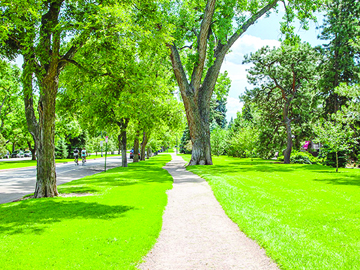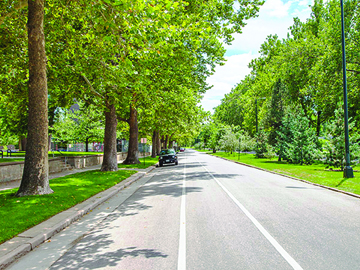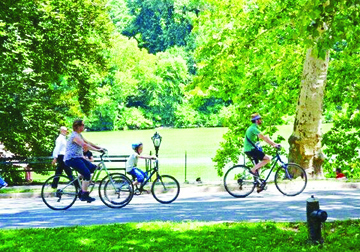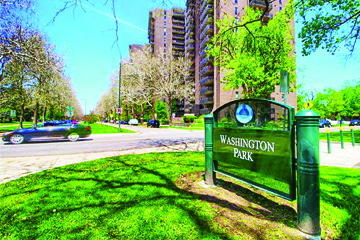Residents, Cyclists Warn Plan Would Harm Picturesque Stretch, Best Bike Ride In Denver
by Glen Richardson
Listed on the National Register of Historic Places in 1986, South Marion Street Parkway is designed with a wide expanse of turf, flowering shrubs, and a natural coniferous forest of pine, spruce and fir. Many longtime local cyclists claim it is, “the best bike ride in Denver.” Residents have chosen to live here because of the serene beauty it affords as Denver continues to grow and expand.

Stretching four blocks, this linear parkway passes through a residential neighborhood before it terminates at the north edge of Wash Park. Appearing in a component of George Kessler’s 1907 plan for the Denver Park & Parkway System, the land was acquired in 1909 and the parkway was largely completed four years later. Landscape architect S.R. DeBoer bordered the parkway with an allee of deciduous trees: Elms line the parkway at its northernmost end as it connects with Speer Blvd., red oak and honey locust parallel the central segment, and sycamore trees were planted to create a dramatic formal entrance to Wash Park.
More than 105 years later, the bicycle bullies at Denver Public Works want to deface the historic parkway with curbs and plastic posts to physically buffer bike riders from cars. Led by bike activist Samuel Piper, the department is eager to spend the $18 million bundle it is getting. The money is the department’s share of cash from a 2017 voter approved billion buck loan to build stuff around the city.

Bike Lane Blasphemy
“Protecting these parkways with their tree-lined sidewalks creates the green oasis, visual beauty and character that defines Denver,” say about 180 neighborhood residents who signed a petition against the plan. They recently dropped the petition off at the Mayor’s office.
Maintaining the city should “leave the bike lane as is,” these residents believe the plan is “four blocks of unnecessary aggravation.” Noting that the bike path already exists, they suggest the proposed changes would be a marginal enhancement for a few to the detriment of the many local residents. Moreover, they submit it is dishonest and illegal. “The city’s proposal is a solution in search of a problem, they argue. “There are less intrusive ways to accomplish these goals,” they conclude.
Patsy Brown who attended a city hosted public meeting on the plan says, “I asked if they were aware the parkway is part of the Denver Landmark of Historic Places. They seemed unaware nor did they care,” she says in frustration and anger. Brown lives in one of several high-rises along S. Marion Parkway. In viewing the rather strict guidelines for single family homes that front to a designated parkway, it seems only logical that the parkways themselves should adhere to the same level of protection.
Biker Opposition
Despite backing for the city plan by former BikeDenver members — BikeDenver and Bicycle Colorado recently merged — many avid area cyclists oppose high-comfort lanes along the parkway. They say bike traffic is so light here changes simply aren’t needed. “Instead someone needs to monitor how fast the bicycles along here are traveling,” they submit.

Their point: “This is a special four-block stretch of bike lanes designed to be enjoyed for its tranquil, peaceful splendor. The lanes here were never designed to be used as a racetrack for bikers going to Wash Park.”
Citizens living in and around Marion Parkway are, of course, pleased local bikers within the area appreciate the parkway. Resident Patsy Brown say, “My concern, and that of most of the residents along the parkway, is that the proposed High Comfort bike lanes do not take into account the protected status of our parkway and would in fact, desecrate it.”
Residents Ignored
“There has been no transparency and our input has not been welcomed,” adds Ruth Ann Zisser displaying her annoyance and irritation. She lives in the parkway’s Marionpark Condominiums.

“Many of us believe the government of Denver and its departments involved with this project have been very careful to make sure none of us knew about their plans until the last minute,” Zisser tells the Chronicle.
“That,” she continues, “is after the city had input and planning from the bicycle transportation groups but not from the citizens who live in this neighborhood.”
School Concerns
Steele Street Elementary takes up a full block along the east side of the parkway and area parents worry that adding protected bike lanes will only add to the congestion and increase danger to both school children, parents and bikers.
Despite assurances to the contrary by the city, residents also express alarm that fire trucks answering calls to one of four condos on the east side of the parkway will not have enough room to navigate their trucks.
They point out that fire trucks are called to the parkway at least once a week “Any lessening of space would greatly impede their ability to answer calls in a timely fashion,” they fear.
A Higher Standard
“We just want to get the word out to our neighbors in Wash Park and elsewhere because there has been virtually no notice given, and our fear is that it will be another fait accompli as the city decides to move ahead with the design,” those living on Marion Parkway say.

Protected bike lanes are not new to Denver, but they are sparse compared to the traditional lanes painted on the periphery of roads. They exist mostly on downtown streets and along South Broadway, but never along a protected parkway registered on the National Register of Historic Places.
The significance of keeping these four blocks from being defaced by Denver Public Works is clarified faultlessly by the city’s own Designated Parkways & Boulevards Guidelines: “Denver’s designated parkways and boulevards elevate The Street to an even higher standard of urban design. They are both street and parkland and are the ribbon that ties our historic parks and neighborhoods together.”
